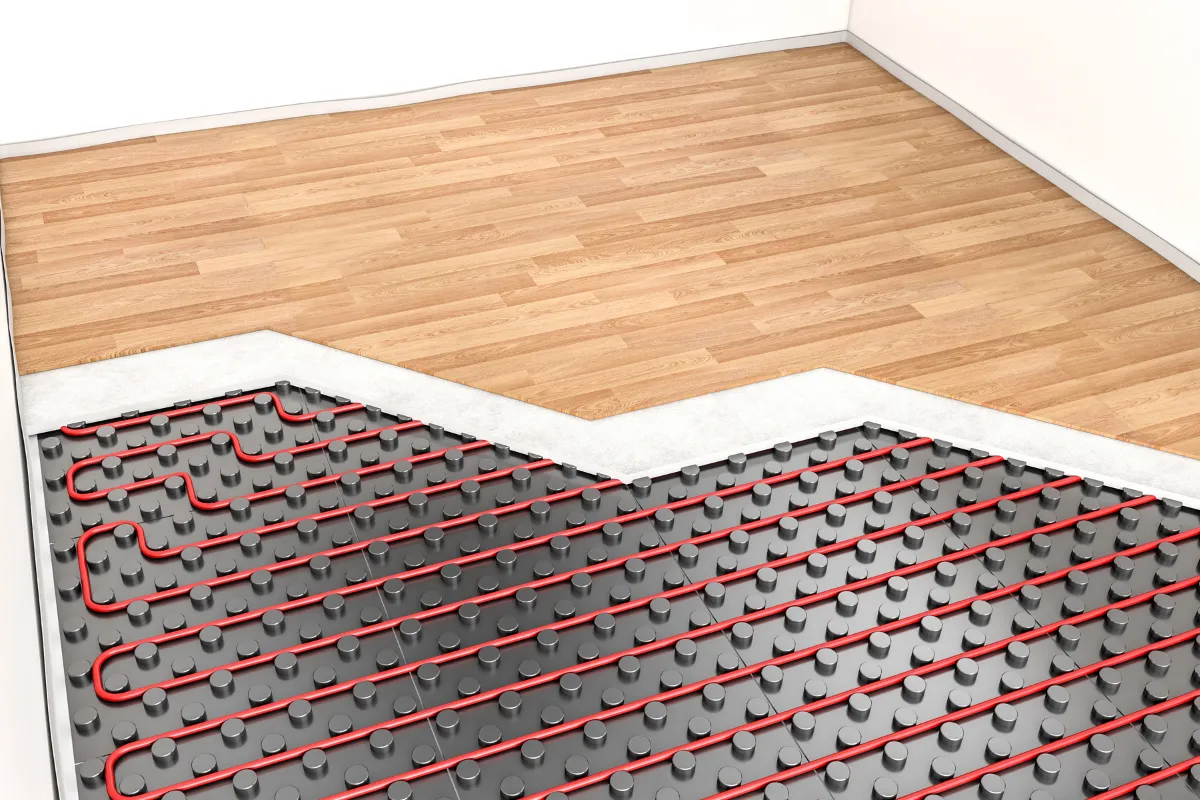Electric floor heaters are becoming increasingly popular in homes and offices. They provide a comfortable and consistent heat, but there are a lot of misconceptions surrounding them. In this first-time buyer’s guide, we will dispel some of the most common myths about electric floor heaters to ensure you are well-informed when making your purchasing decision.
What exactly is an electric floor heater? It’s a heating system installed beneath your floor covering designed to provide comfortable, consistent floor heat throughout your living spaces.
Gone are the days when most relied on a traditional forced-air system to warm our feet. Electric floor heating offers a much more energy-efficient, allergen-free, and uncomplicated solution for maintaining a warm floor.
The Benefits Of Electric Floor Heaters
- Efficiency: Electric radiant floor heating systems deliver an even heat distribution, reducing energy consumption.
- Allergen-free: Unlike forced air, underfloor heating doesn’t circulate allergens, providing a healthier indoor environment.
- Customizable: Tailor the system based on your choice of floor covering, whether tile, laminate, or vinyl.
- Easy installation: Skilled installers can integrate electric floor heaters relatively easily into your subfloor.
Now that we have grasped the essence of a floor heater electric system let’s unravel the misconceptions surrounding this innovation.
Myth 1: Floor Heater Electrics Are Too Expensive To Run
One of the most persistent myths about electric floor heaters is that they are costly to operate. While it’s true that electricity can be more expensive than other heating sources like gas, modern electric floor heaters are very energy efficient.
In essence, electric radiant floor heating systems are meticulous heating solutions that employ heating wire to deliver consistent in-floor heating. While their upfront cost may seem higher than traditional air systems, the long-term benefits of an electric underfloor heating system shouldn’t be underestimated.
Electric floor heating stands out due to its efficient heat distribution compared to other heating sources. Rather than wastefully heating the air, thereby risking heat loss and uneven temperatures, these heating elements distribute heat directly under your floor surface – heating objects in the room and people from the ground up.
Moreover, the cost of running your electric floor heater primarily depends on the size of your room and the type of floor. For instance, a well-insulated room with a new floor above a concrete slab will benefit from a more efficient heating system than a less insulated room.

Fact: A well-insulated room with a modern electric floor heater can actually cost less to heat compared to traditional central heating systems.
Suppose you’re after an even heat distribution, energy efficiency, and the heavenly feeling of a warm floor when you step on it. In that case, an electric floor heating solution is worth every penny!
Myth 2: Floor Heater Electrics Are Unnecessary Luxuries
A new floor can harness the ease of installing electric heating mats in properties with uneven floor joists, turning chilly rooms into cozy havens. Similarly, for homes in colder regions, an electric floor heating system isn’t a luxury but a beneficial primary heat source that provides heat directly to people and objects, ensuring a warm and cozy atmosphere.
Dancing between luxurious comfort and practicality, the electric floor heating system stands firm, repelling the misconception that it is merely an excessive luxury.
Mainstream air systems pump hot air into a room and hope it reaches you. Electric floor heaters, however, directly heat the floor beneath you, offering a superior heat distribution that increases comfort levels and can help keep the house energy-efficient.
So, next time you hear someone label these systems as unnecessary luxuries, be prepared to surprise them with the practical benefits of floor heater electric systems. Far from an unnecessary splurge, electric underfloor heating is indeed a delightful mix of practicality, comfort, and efficiency.
Myth 3: Installation Of Electric Floor Heaters Is Too Complex
Many people assume that electric floor heaters are difficult to install. In reality, they can be quite easy to set up, depending on the type you choose. Here is how to go about it:
- Step 1: Assess the area
For electric underfloor heating, measure the floor surface to determine the desired heat output and select the right floor heating products for your type of floor. - Step 2: Plan the layout
Sketch out your layout, ensuring even heat distribution throughout the room. Remember to leave a gap around the perimeter for easy fitting. - Step 3: Clean and prepare
Sweep, vacuum the area, and fix insulation on the subfloor to reduce heat loss. - Step 4: Lay the heating elements
It’s time to install the electric heating cables or heated floor mats, depending on the system. Remember to leave some space for the floor heating thermostat. - Step 5: Install the floor sensor
Link the floor sensor to the heating thermostat, securing it between two heating wire loops. - Step 6: Test the system
Test the heating system before laying the final floor layer to ensure it operates seamlessly. - Step 7: Complete flooring
Lay your desired floor type (tiles, vinyl, linoleum, wood, etc.) on top of the heating elements, and voilà! Enjoy your cozy, warm, newly heated floor!
Fact: Electric floor heaters can be an easy DIY installation project or can be installed by a professional if you prefer.

Myth 4: Electric Floor Heaters Can’t Heat Large Rooms
Some may assume that electric floor heaters can’t heat large spaces effectively. However:
Fact: Electric floor heating systems are capable of heating large spaces provided they are designed and installed correctly.
You can consult with a professional or use online calculators to determine the correct size and wattage of the heater for your space.
No matter the size of your space, electric underfloor heating can stand tall as a primary heat source using a tailored approach. With a wide variety of floor heating products designed for different room dimensions, the size of the room is only a detail.
How exactly does this work? The heating elements embedded beneath the floor radiate heat throughout the room by transferring warmth to people and objects instead of floating aimlessly like forced air. The result? A uniform, cozy ambiance is also suitable for larger spaces.
Size is no longer your excuse to live without the warmth of an electric floor heater!
Floor Heaters, The New Home Comfort Heroes
Safety concerns are also common when discussing electric floor heaters. People may worry about fires, electrical shocks, or harming their children and pets.
Fact: Modern electric floor heaters are designed with safety features, such as:
- Ground fault protection to prevent electrical shocks.
- Overheating protection to shut off the system if it becomes too hot.
- Low surface temperatures, making them safe for children and pets.
Concerns about the environmental impact of electric floor heaters stem from the assumption that all energy is created equal.
Electric floor heaters can be a greener option when powered by renewable energy sources. Additionally, their energy efficiency can help reduce your overall energy consumption, minimizing your carbon footprint.
Whatever the floor, shape, or size, electric floor heating is the silent, invisible knight standing against winter’s chill, driving away the icy nip beneath your feet the moment you step on them. Now that you’re armed with truth, perhaps it’s time to experience a warm floor underfoot.

In conclusion, electric floor heaters are an excellent choice for many homes and offices when you need to add supplemental heating or replace an old system. Dispelling these myths helps you understand the benefits, efficiency, and safety of these systems, ensuring you make a well-informed decision when purchasing your electric floor heater.



0 Comments